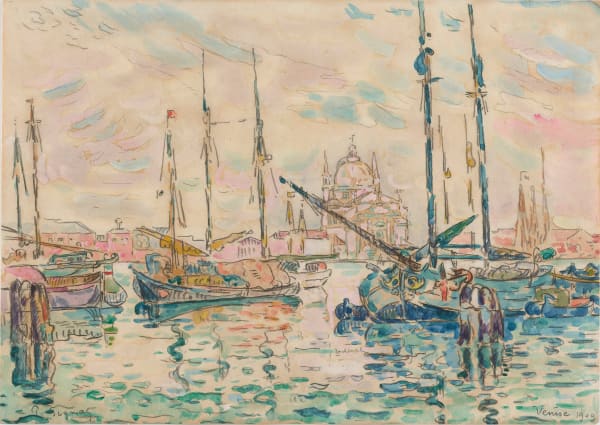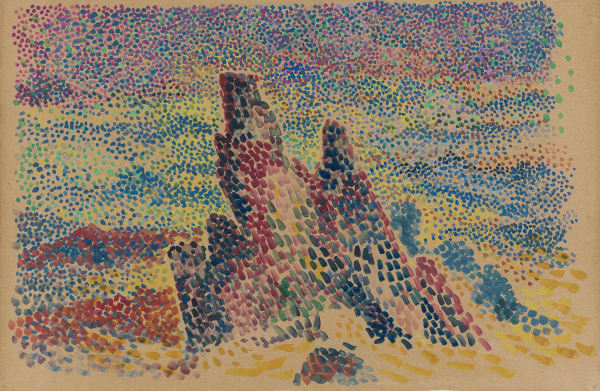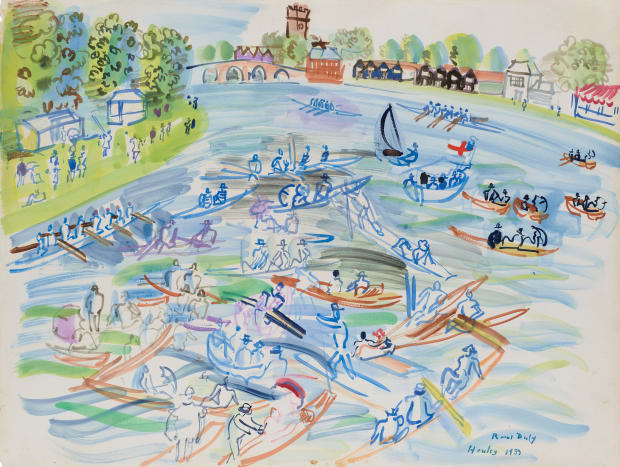-
Nineteenth Century
-
Though differing from one another, these three nineteenth-century works on paper – attributed to Hawkins, Jongkind and Millet respectively – represent the artist’s initial emotional and psychological reaction to their environment.
Using charcoal to experiment with illusions of volume and weight, Millet imbued the inanimate objects in his kitchen, with life and character.
Similarly,though influenced by Symbolist tradition, Hawkin’s use of watercolour allowed for the expression of romantic and nostalgic feeling.
For Jongkind, watercolour became a tool through which he could convey the nature of water itself, and the gradations of light and sky.The resultant shimmering effect translates the energetic, emotional character of the scene. Often executed ahead of studio painting, these works were embodiments of the artist’s evolving and percolating ideas.
-
‘He [Millet] has left us several drawings which enable us, step by step, to follow the development of his idea through its successive stages.’
(Julia Cartwright, 1902; in Jean Francois Millet, his Life and Letters; Swan Sonnenschein en Co, Lim. London / The Macmillian Company, New York; second edition, September 1902, p.112.)
-

-
[...]The longer one looks at his watercolors, the more one wonders how he does them! They are made from nothing and yet the fluidity and the density of the sky and clouds are reproduced with unbelievable precision..
Quote of Eugène Boudin in 'L'Art, XLIII', 1887; cited by Victorine Hefting, in L'Univers de Jongkind, Paris 1976, p. 60
-
Signac admired and collected Jongkind whom he called a 'friend of boats and wind'. In the 1927 monograph Signac devoted to Jongkind, he thought watercolours were the most characteristic part of the Dutch artist’s work, 'the part that teaches us to know him better and love him more'....
-
Artists
-
Artworks
-
 Jean François MilletLe vaisselier de GruchyStamped lower leftCharcoal28.9 x 22 cm
Jean François MilletLe vaisselier de GruchyStamped lower leftCharcoal28.9 x 22 cm
11 3/8 x 8 5/8 inchesView more details -
 Louis Welden HawkinsPaysanne sur le cheminSigned lower leftWatercolour on paper37 x 23.9 cm
Louis Welden HawkinsPaysanne sur le cheminSigned lower leftWatercolour on paper37 x 23.9 cm
14 9/16 x 9 7/16 inchesView more details -
 Johan-Barthold JongkindVue du Port de Dordrecht, 1869Bears the posthumous sale stamp (L.1401) Located, dated and signed lower right Dort S. Oct 69 JongkindWatercolour and black pencil on paper28.7 x 45.6 cm
Johan-Barthold JongkindVue du Port de Dordrecht, 1869Bears the posthumous sale stamp (L.1401) Located, dated and signed lower right Dort S. Oct 69 JongkindWatercolour and black pencil on paper28.7 x 45.6 cm
11 5/16 x 17 15/16 inchesView more details
-
-
Pointillism
-
Both Signac and Petitjean were inspired by their meetings with Georges Seurat, who had endeavoured to study contemporary scientific theories, such as those related to optics and colour published by Michel-Eugène Chevreul.
The two Pontillist artists used palettes of remarkable colour vibrancy; dabs of paint were applied in small, rapid strokes. The consequent illusionary effect of layering enhanced the richness of colour and brightness of composition, creating a ‘coloured light’. Through these techniques,
the artists could experiment with how best to convey the liveliness of the depicted scene. ‘Watercolour’, as Signac stated, ‘[is] a playful game’.
-
"Watercolour is just a method of making notes, a sort of memorandum, a rapid and productive process enabling the painter to increase his repertoire of elements too short-lived to be captured by the slow process of oil painting. A cloudy sky is a magnificent subject, but is constantly changing". (Paul Signac - Jongkind, Georges Crès & Cie, 1927)
-

-

-
Artists
-
Artworks
-
 Paul SignacVenise, le Rédempteur, 1909Signed lower left, dated and located lower right ‘Venise 1909’Watercolour and gouache on paper29.1 x 40.9 cm
Paul SignacVenise, le Rédempteur, 1909Signed lower left, dated and located lower right ‘Venise 1909’Watercolour and gouache on paper29.1 x 40.9 cm
11 7/16 x 16 1/8 inches -
 Hippolyte PetitjeanMer agitée sur la côte, c.1900Stamped lower left with the studio stamp (Lugt 2022c)Watercolour on paper20 x 30 cm
Hippolyte PetitjeanMer agitée sur la côte, c.1900Stamped lower left with the studio stamp (Lugt 2022c)Watercolour on paper20 x 30 cm
7 7/8 x 11 13/16 inches
-
-
Raoul Dufy
-
The artist’s naïve, loose style is most prevalent in his watercolours, both in his technique and the bold, colourful, decorative compositions.
In two later works, Régates à Henley (1933) and Roses Rouges (1941), we see Dufy’s typical inclination to sketch outlines set against distinct, thin layers of brightly coloured paint. The rapid motions he employed to accomplish this idiosyncratic effect, has been likened to stenographic notation.
-

-
“I paint with my colour-light which get its shinning power from itself, where in reality, the sun brings colours to life by lighting them.”
(Notebook 9, pages 44 – MNAM documentation. Quoted in the catalogue of the exhibition Raoul Dufy – Le Plaisir, Musée d’Art Moderne de la Ville de Paris.)
-
Artworks
-
Artists
-
André Derain
-
During his successful career, Derain assimilated a variety of artistic styles; his drawings and watercolours can be construed as essential experiments with colour, composition, subject and technique.
Considering these works, we see Derain’s persistent reflections on how best to provoke the individual’s emotional perception through art.
As painter, sculptor, printmaker, illustrator and set/costume designer, working on paper enabled an open and flexible dialogue between two-dimensional and three-dimensional artistic creation, such as sculpture or ballet set design. In open dialogue, working from paper, Derain was able to experiment with influences from the neoclassical to modern, the primitive and medieval, and the non-European.
-

-
It is the mission of art to equalise time. And the notions of universals and of identity must be respected [...] Art is still and always will be the memory of generations ( André Derain, Peintres d'Aujourdhui: Les Maitres, Collection Comoedia-Charpentier, Paris, 1943 )
-
We must seize nature in all its economy, its movement, its imaginative development...(Quote in Leland Bell, The Case for Derain as an Immortal, Art News, 59, May 1960, p.27)
-
For I perceived that man's estate is as a citadel: he may throw down the walls to gain what he calls freedom, but then nothing of him remains save a dismantled fortress, open to the stars [...] Citadel, I will build you in men's hearts.
(Wisdom of the Sands, "La Citadelle" by Antoine de Saint-Exupéry, posthumously published in 1948) -
Artworks
-
 André DerainPaysage près de Martigue, c.1908Stamped lower right (Lugt 668a)Pen and black ink on paper27 x 32.7 cm
André DerainPaysage près de Martigue, c.1908Stamped lower right (Lugt 668a)Pen and black ink on paper27 x 32.7 cm
10 5/8 x 12 7/8 inches -
 André DerainTete de Femme, c.1935Stamped lower right (Lugt 668a)Sanguine on paper30.8 x 23.3 cm
André DerainTete de Femme, c.1935Stamped lower right (Lugt 668a)Sanguine on paper30.8 x 23.3 cm
12 1/8 x 9 1/8 inches -
 André DerainDeux têtes, c.1920Stamped lower right (Lugt 668a)Pencil on paper28.8 x 18.7 cm
André DerainDeux têtes, c.1920Stamped lower right (Lugt 668a)Pencil on paper28.8 x 18.7 cm -
 André DerainGentilhomme, 1945Stamped lower right ( Lugt 668a)Watercolour on paper23.7 x 15.2 cm
André DerainGentilhomme, 1945Stamped lower right ( Lugt 668a)Watercolour on paper23.7 x 15.2 cm
9 5/10 x 6 inches -
 André DerainTête de femme, c.1940Stamped lower right (Lugt 668a)Watercolour on paper30.8 x 23.5 cm
André DerainTête de femme, c.1940Stamped lower right (Lugt 668a)Watercolour on paper30.8 x 23.5 cm
12 1/8 x 9 1/4 inches -
 André DerainL'oiseau, c.1950Stamped lower right (Lugt 668a)Watercolour and gouache on paper24.7 x 31.5 cm
André DerainL'oiseau, c.1950Stamped lower right (Lugt 668a)Watercolour and gouache on paper24.7 x 31.5 cm
9 3/4 x 12 3/8 inches -
 André DerainEtude pour La Citadelle de Saint-Exupéry, c.1950Stamped lower right ( Lugt 668a)Gouache and watercolour on paper21.6 x 16.5 cm
André DerainEtude pour La Citadelle de Saint-Exupéry, c.1950Stamped lower right ( Lugt 668a)Gouache and watercolour on paper21.6 x 16.5 cm
8 ½ x 6 1/2 inches
-
-
Artists
























